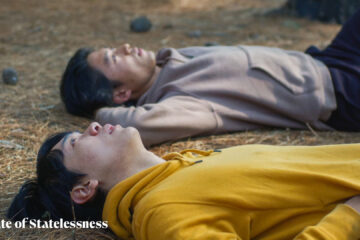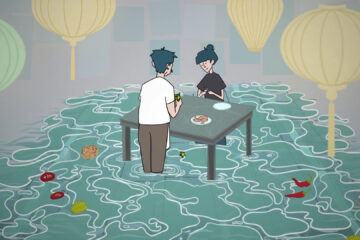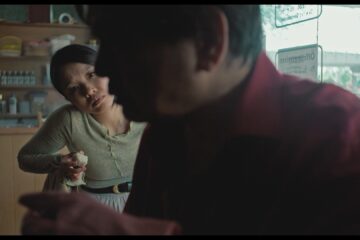In this exclusive interview, Trịnh Đình Lê Minh, director of Once Upon a Love Story, shares his meditations on homecoming, love, and the temporal and spatial dimensions of the film. He also articulates his strategies for collaborating with the crew, adapting the original novel for the screen, and keeping a balance between his dual roles as filmmaker and teacher.
Interviewee: Trịnh Đình Lê Minh, director of Once Upon a Love Story
Interviewer: Xiangu Qi
Once Upon a Love Story opens with the male protagonist’s homecoming, echoing a similar beginning in your 2019 film Goodbye Mother (VFF 2021). What does “homecoming” mean to you, and what draws you to begin your stories in this way?
Homecoming means a lot to me. To me, it’s about returning to our true selves with fewer defenses. It’s also the moment when we have to confront the truth – our essence – without masks or concealment.
Rural Vietnam recurs throughout your films. Why is the rural landscape so central to your work, and what do you hope audiences take away from the way you portray it – often in an idyllic tone?
Rural Vietnam carries within it a deep paradox. Beneath the serene, picturesque surface lies a web of tensions – between traditions and changes, individual desires and communal expectations, memories and modernity. That’s why I find it such a compelling setting: it forces characters to confront reality and, more importantly, themselves. For me, these landscapes aren’t just backgrounds; they’re living spaces of conflict and reconciliation. After all the inner struggles and movements – physical or emotional – the return to the countryside often becomes a space for peace, clarity, and honesty.
Both the cinematography and costume design in Once Upon a Love Story are striking. How do you collaborate with your creative team across departments, and what strategies do you use to ensure your vision is fully realized onscreen?
Collaboration is the key. I always start by sharing my vision clearly with the team – through detailed discussions, visual references, and mood boards – so everyone understands the tone and emotional core of the story. From there, I give each department space to bring their creativity while maintaining open communication. We constantly exchange ideas and adjust based on what serves the narrative best, ensuring that cinematography, costume, and all elements work in harmony to express the film’s spirit.
While Once Upon a Love Story is a love story, it explores more than just romance. What does “love” mean in your filmmaking, and what broader ideas were you hoping to convey through this theme?
This is a story about love, certainly, but in a broader sense – love as friendship, love as humanity. I wanted to explore how these forms of love shape who we are and connect us beyond romance.
The film adapts Nguyễn Nhật Ánh’s novel of the same name. What challenges did you face in bringing the novel to screen? Which elements did you feel were essential to preserve, and what intentional changes did you make, and why?
Nguyễn Nhật Ánh’s stories always carry a sense of nostalgia and recurring motifs – unrequited love, moments of despair, and, ultimately, peace after overcoming the struggles of adolescence and understanding oneself in relation to love and home. These were essential for me to preserve: love, friendship, the losses of growing up, and the acceptance that leads to tranquility. At the same time, we needed to build additional events and situations so the story could unfold cinematically – where characters act and confront challenges, rather than being confined to their internal monologues.
The Vietnamese summer plays a crucial role in shaping the narrative, the characters, and the film’s atmosphere. What aspects of this temporality did you want to highlight, and how did you translate them cinematically?
Summer is the season of transition – when students face growth, move up a grade, graduate, and bid farewell to familiar spaces. It carries the joy of growing up and the excitement of new beginnings, yet it’s also filled with longing and the ache of time passing. I wanted to capture that duality – the brightness of youthful freedom contrasted with the quiet melancholy of inevitable change – through warm, sun-drenched imagery and moments where stillness and silence speak as loudly as the laughter.
As both a filmmaker and a university lecturer in Media and Arts Studies, how do you balance your teaching with your filmmaking career? In what ways do these two roles inform and inspire one another?
These two roles complement each other deeply. After studying in the U.S. and returning to Vietnam, I followed the path of my own professors: teaching as a daily practice while nurturing and developing film projects. To teach filmmaking, you must make films. Conversely, teaching allows me to engage with students, hear their stories, and help them grow – and in doing so, I learn, gain a deeper understanding, and find new inspiration for my own creativity.
Finally, could you share what you are currently working on? Are there particular themes or questions you hope to explore further in your future work – whether as a filmmaker or as a scholar?
I would like to further explore queer stories in Vietnam, as these narratives are currently underrepresented. In addition, I’m currently producing three debut films: two feature films and one documentary. The two features center on women and how they liberate themselves from societal constraints and pressures.
Once Upon a Love Story will be shown on Saturday, October 11 at 12 PM at the Frida Cinema in Santa Ana, California.


